A great look back at the final launch of the space shuttle program. Includes some footage I hadn’t seen before, such as views of the crowds gathered to watch the launch, and features all the great quotes from Mike Leinbach, Chris Ferguson, George Diller and Rob Navias.
Shuttle Duo Nose-to-Nose Rendezvous highlights Retirement Duty
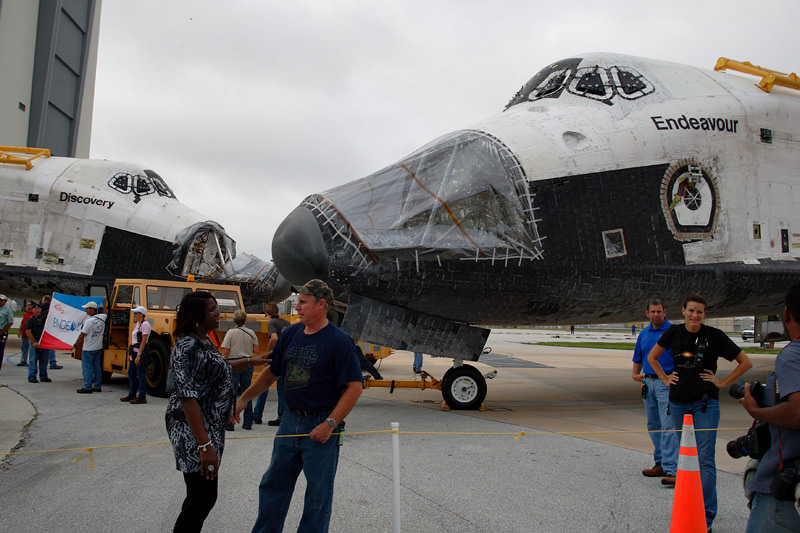
[/caption]
To see one shorn shuttle is bad enough. Seeing two NASA space shuttles edged together and voluntarily gutted of their spaceflight capability for lack of Federal Government funding in the prime of their lives is beyond sad.
Two of NASA’s trio of space shuttle orbiters – Discovery & Endeavour – switched locations at the Kennedy Space Center (KSC) on August 11, moving them further down the path to eternal retirement and public exhibit at their future homes in museums. That’s far afield from their intended purpose to soar as spaceships of exploration to the High Frontier.
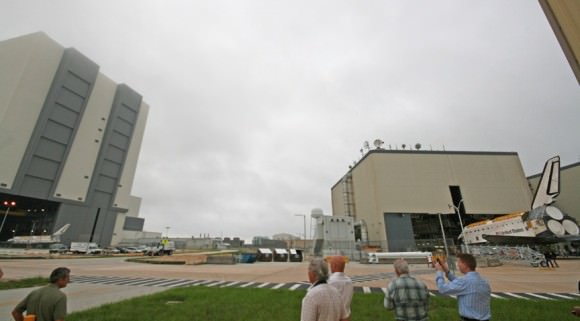
Discovery and Endeavour briefly met in a matchless nose-to-nose configuration for a roadside photo opportunity between the humongous Vehicle Assembly Building (VAB) and the processing hanger – dubbed the Orbiter Processing Facility – where the orbiters are prepared for flight.
Space Shuttle’s Discovery and Endeavour swapped places at KSC so that technicians could resume preparations towards the transition and retirement of shuttle Discovery – the first of NASA’s orbiters to be officially withdrawn from active duty spaceflight service.
First, Discovery was backed out of temporary storage from a high bay inside the VAB. Then Endeavour was towed out of Orbiter Processing Facility-1. Technicians then maneuvered the orbiters to a rendezvous point in between on the ground. Just imagine how grand this vista would have appeared in space.
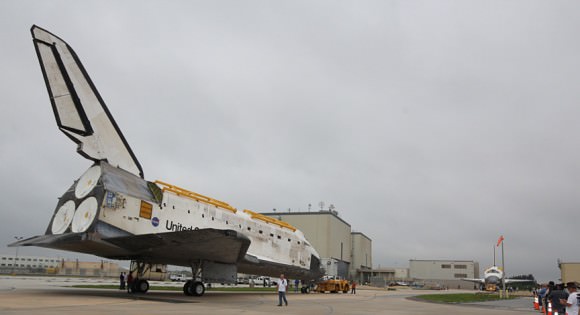
At last Discovery and Endeavour met for the truly sad nosy encounter of gaping holes where the forward reaction control thrusters once fired to meticulously maneuver the shuttles in orbit. Protective plastic sheeting meant to shield the empty thruster bay from FOD – or Foreign Object Debris – was in tatters and whipping wildly in the wind almost from the moment Discovery emerged from the VAB.
The rear ends of both orbiters looked like the main engines had been sawed off. Both orbiters have been stripped of their trio of mighty space shuttle main engines (SSME’s) and duo of bulbous Orbital Maneuvering System (OMS’s) pods for months of decommissioning work.
Discovery was then pulled into the Orbiter Processing Facility-1 (OPF-1) where the next step is to extract even more of her guts, namely the Auxiliary Power Units (APU’s) and associated systems for “safing” over the coming months. In April 2012, Discovery is scheduled to depart KSC forever and be flown off for permanent public display at the Smithsonian’s National Air and Space Museum Steven F. Udvar-Hazy Center in Virginia.
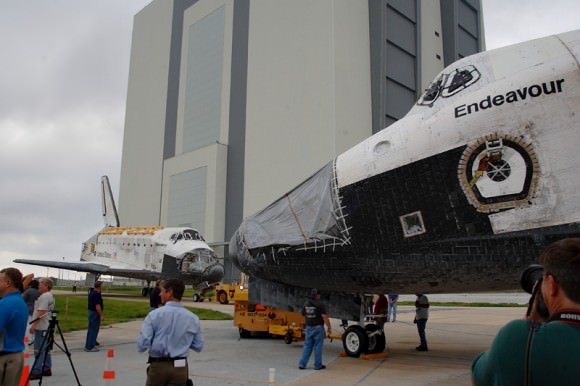
Endeavour was towed into the VAB for storage until October, when she will be moved into OPF-2 for further work to ready her for public display at the California Science Center in Los Angles sometime next summer.
Atlantis is next on the chopping block. And America retains zero indigenous capability for human spaceflight.
The situation likely won’t change for at least several years until one of the commercial providers launches a human rated “space taxi” to low earth orbit.
Read my continuing features here about Discovery, Endeavour and Atlantis
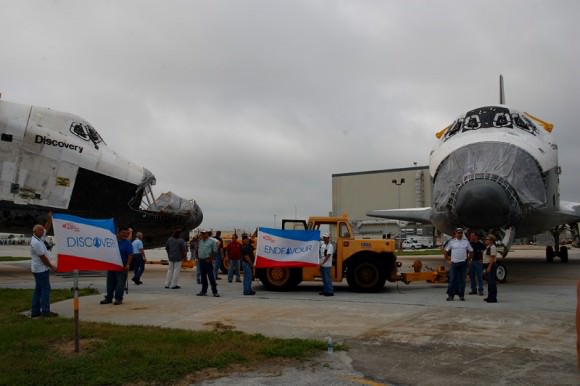
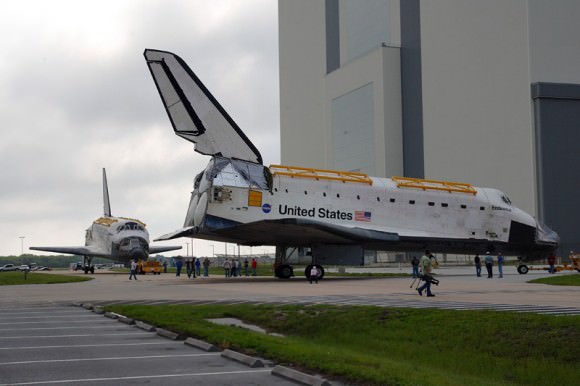
Atlantis Final Crew and NASA thank Shuttle Workforce with space flown Tribute Banner
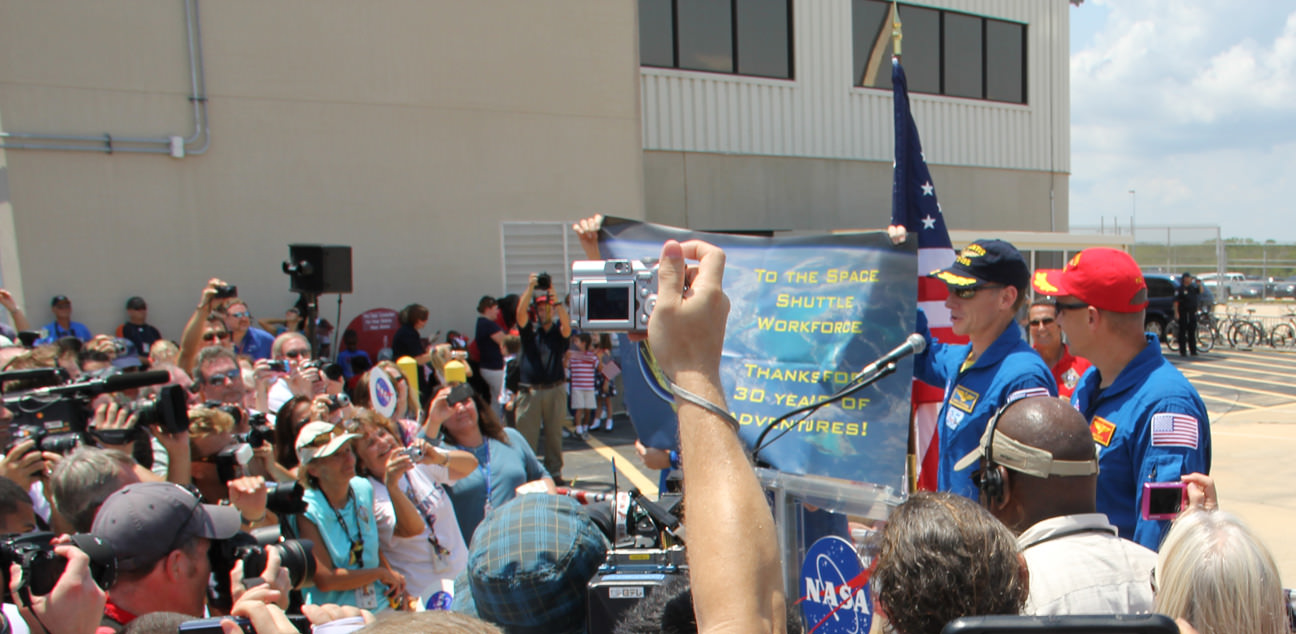
[/caption]
Following the majestic predawn touchdown of Space Shuttle Atlantis at the Kennedy Space Center (KSC) to close out the Space Shuttle Era, the final crew of Atlantis, NASA Administrator Charles Bolden and KSC Director Bob Cabana thanked the Space Shuttle workforce for their dedication and hard work at an employee appreciation event held outside the processing hangers where the orbiters were prepared for the 135 shuttle missions flown by NASA over more than thirty years.
The four person crew of Atlantis on the STS-135 mission flew a special commemorative banner millions of miles to the International Space Station and back in honor of the thousands of workers who processed, launched and landed America’s five space shuttles. They unfurled the banner at the employee event at KSC in tribute to the shuttle workers.
“It’s great to be here in sunny Florida,” said STS 135 Commander Chris Ferguson. “Mike Leinbach [ the Space Shuttle Launch Director] said there was no way he’d let us land in California.”
“We want to express our gratitude on behalf of the astronaut office for everything you have done here at KSC, the safety you have built into the vehicles, the meticulous care that you take of the orbiter. As soon as we got on orbit, I was absolutely amazed that everything in Atlantis works so well. Everything looks beautiful on the inside.”
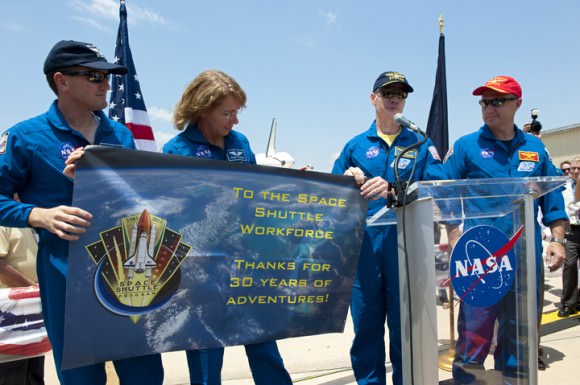
“I hope you all believe that every time we go, we take a little bit of every one of you with us,” Ferguson emphasized.
Atlantis was parked at the event as a backdrop for photo opportunities with the thousands of shuttle workers in attendance – along with over a hundred journalists including the Universe Today team of Alan Walters and Ken Kremer.
“Like Chris said, our one landing option was getting back to Florida and you all rather than anywhere else. It felt like being home again. Thank you for everything you have all done over the last 30+ years,” said Doug Hurley.
“We treated Atlantis with the utmost respect because we see firsthand how you process this vehicle and it is your baby,” said Rex Waldheim. “It is clean and well cared for. We did that for you because you all did such a great job preparing it for us.”
“You are such a special work force,” added Sandy Magnus. “There is no workforce like the space program workforce anywhere in the world. The pride, care, dedication and passion you take in your work is what makes it possible to have these very challenging missions and to succeed. You have to do everything right all of the time. And you DO. And you make it look easy!! Congratulations!”
The STS-135 crew then unfurled the colorful banner taken to the ISS aboard Atlantis to commemorate NASA’s Space Shuttle Era.
“We took this banner with us to space and this is our way of telling you that you guys rock ! We will present this to Mike Leinbach and Bob Cabana as just a small token of our appreciation for all the work you’ve done for us. Thank you for such a wonderful vehicle,” Ferguson summed up.
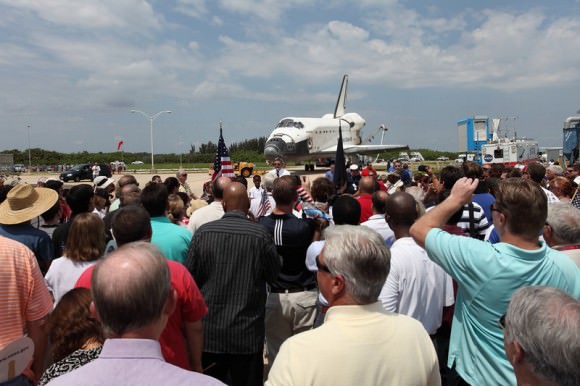
The crew then waved good bye to the thousands of shuttle workers, posed with Atlantis one last time and departed with their families for a homecoming celebration at their training base at the Johnson Space Center in Houston, Texas.
Atlantis was then towed a few hundred yards (meters) and came to rest inside the Orbiter Processing Facility to conclude her final spaceflight journey as the last of NASA’s flight worthy Space Shuttle Orbiters. She has began decommissioning activities due to last several months to prepare for her future retirement home at the Kennedy Space Center Visitor Complex (KSCVC) just a few miles (km) away.
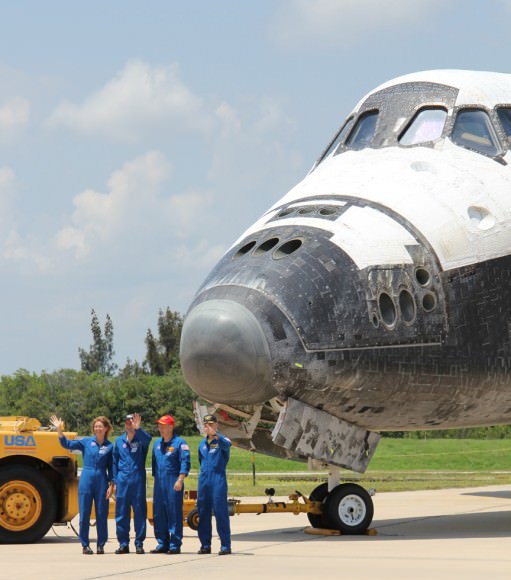
Atlantis permanent new abode at KSCVC is set to open in 2013 where she will be genuinely displayed bearing scorch marks from reentry and as though “In Flight” with payload bays doors wide open for the general public to experience reality up close.
For some 1500 shuttle workers, the day’s proceedings were both joyous and bittersweet – as their last full day of employment and last chance to bask in the glow of the triumphant conclusion of the Shuttle Era.
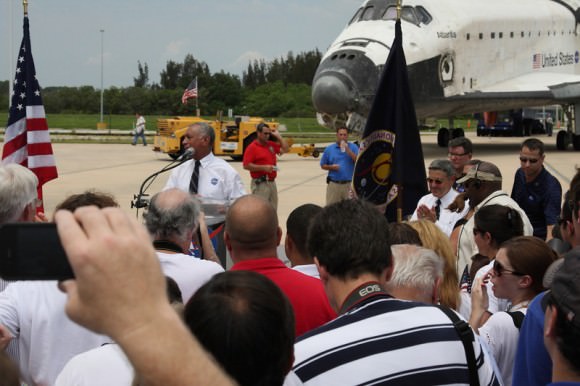
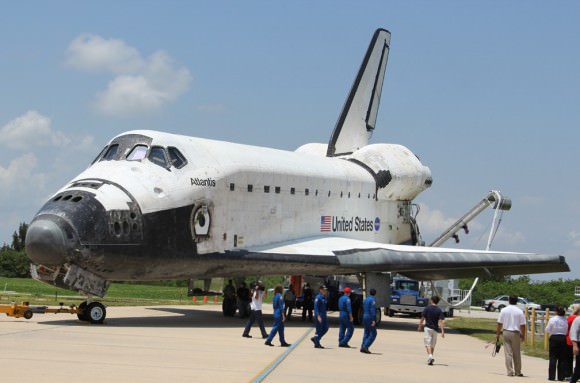
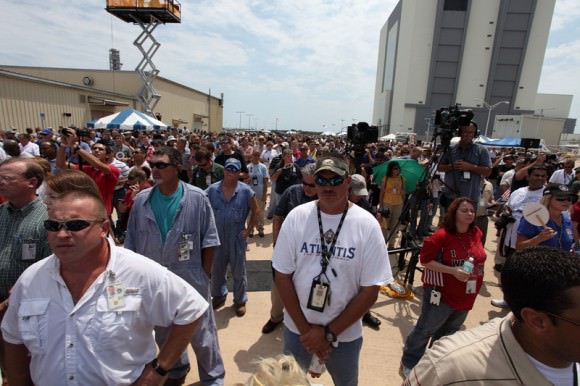
Chasing Rockets, Chasing History: One Journalist’s Video Reflections
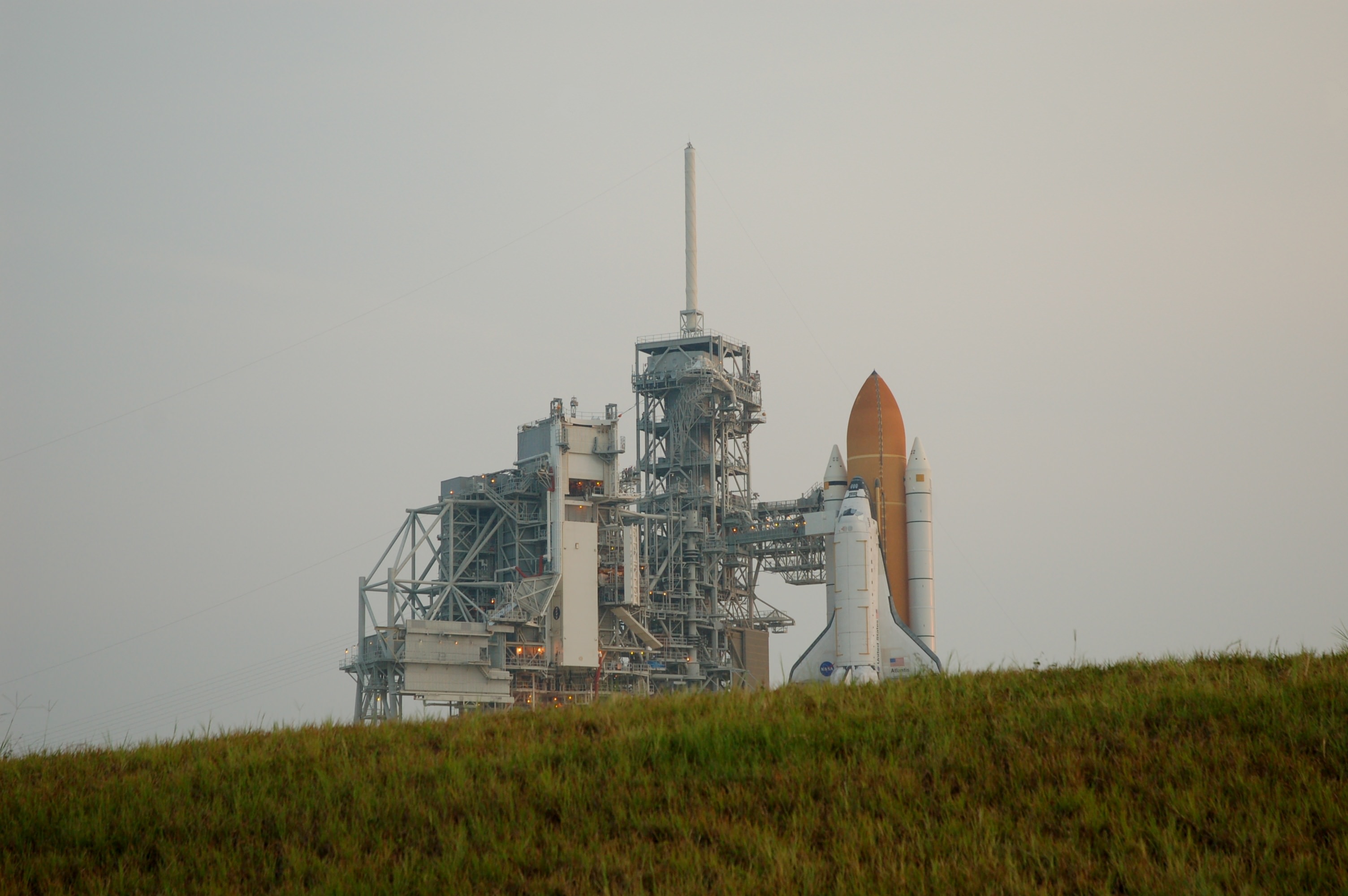
[/caption]
CAPE CANAVERAL Fla. – As one might imagine covering the space program is a exciting vocation. Some professionals focus on writing articles or taking pictures others work with television stations or online media outlets to provide video and commentary. I have selected to attempt to do all of the above. This can be rather challenging. During the final launch of Atlantis for example, I conducted interviews with a variety of guests up until the launch, from there I operated two camcorders and a DSLR camera (for stills).
Doing things this way provides outlets with a wealth of different types of content to choose from. This also means that a lot of material is not used. This article will cover some of the things that ended up on the cutting room floor. What was not used – might surprise you.
SpaceX Surprises
Of the NewSpace organizations that have made their presence known out at Kennedy Space Center – Space Exploration Technologies or SpaceX has had the most significant impact. Lately the firm has worked to get the media out, as much as possible, to see what the company is doing. NASA and many of the established aerospace companies have a hands off approach – essentially you report on what they allow you to report. SpaceX? They allowed this reporter to climb underneath the Falcon 9 and even have it spun on command. Check it out:
Shuttle Memories
Trying to accurately record and report the historic nature of what took place at Kennedy Space Center this summer was challenging. I took every opportunity I could to record what was happening and then relay that to the public. What I will always remember from this time was how open the members of NASA were and how they really tried to work with you to get the story out. To get a taste of what it was like, check out this compilation of shuttle videos from STS-133 through STS-135:
Launches
Whilst following the shuttle, the last two years have been punctuated by a number of awesome unmanned flights as well (not including the launch of the Falcon 9 which you can see above). The second OTV space plane, SBIRS, AEHF-1 and an impressive night launch of a Delta IV Heavy all helped to keep me on the road to Cape Canaveral:
Memorable Interviews
I’ve been privileged to interview many important people within the space community. That however does not mean that their interviews will stick out in my mind. Some of the ones that I remember best are from people that have always been a joy to work with. Stephanie Stilson is one of those people, she always has a kind word and a great quote. Greg Johnson is another, bombastic and easy-going, he has no problem whatsoever veering off of the official NASA script. To separate the two interviews I included a clip of the media being escorted up onto LC39A. Click below to watch:
Experiencing History
It is not every day that one gets to train along with the astronauts. I had the opportunity to do so on STS-135. I flew in the back of the Shuttle Training Aircraft (STA) as Commander Chris Ferguson practiced landing the shuttle. To date, this has to be the high point of my career:
Over the last two years I have been bombarded by folks stating that I should report things “their” way. Some want me to go hyper-technical, so that only an engineer could understand what I was saying. While I’m sure some folks wouldn’t mind breaking out a flight manual to keep up with the jargon – that really isn’t what I’m trying to accomplish. Others tell me to keep it as simple as possible and to never state anything that could be construed as negative – but that doesn’t reflect reality. I try to come in somewhere in the middle. The public should know that this is a highly technical endeavor – but they should also know that it is exciting, that this tale is not one without issues and that I try to show it all, the good, the bad and the awesome.
Last Towback of a Flight Worthy Space Shuttle – Atlantis Post Touchdown Photo Album

[/caption]
Space Shuttle Atlantis closed out NASA’s Space Shuttle Era with a safe touchdown on July 21, 2011 at the Kennedy Space Center in Florida at the conclusion of the STS-135 mission, the 135th and final shuttle mission.
I was extremely fortunate to be an eyewitness to history and one of the lucky few journalists permitted by NASA to follow along as Atlantis took her historic final journey back from wheels stop at Runway 15 at the Shuttle Landing Facility as a flight worthy orbiter.
A convoy of 25 specialized vehicles safe each orbiter after landing. Some four hours later, Atlantis was towed off the runway with a diesel powered tractor for about 2 miles along the tow way leading to the Orbiter Processing Facility which lies adjacent to the Vehicle Assembly Building (VAB) at KSC.
The STS-135 crew consisted of Shuttle Commander Chris Ferguson, Pilot Doug Hurley and Mission Specialists Sandra Magnus and Rex Walheim.
Check out my Towback Photo Album below, and prior album from wheels stop at the shuttle runway earlier in the day, here:
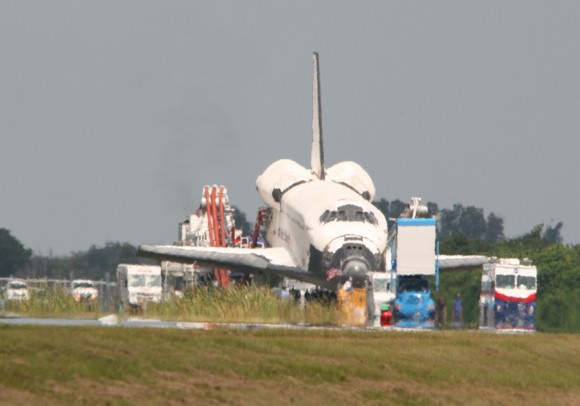
Credit: Ken Kremer (kenkremer.com)
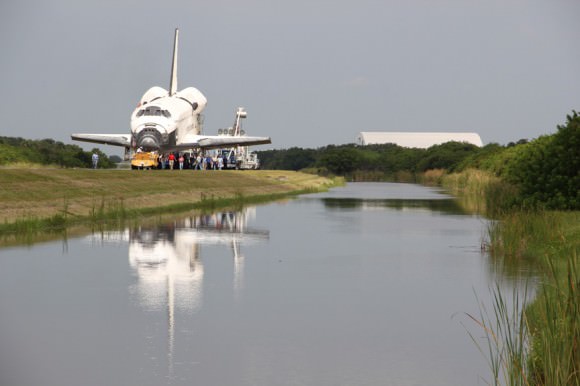
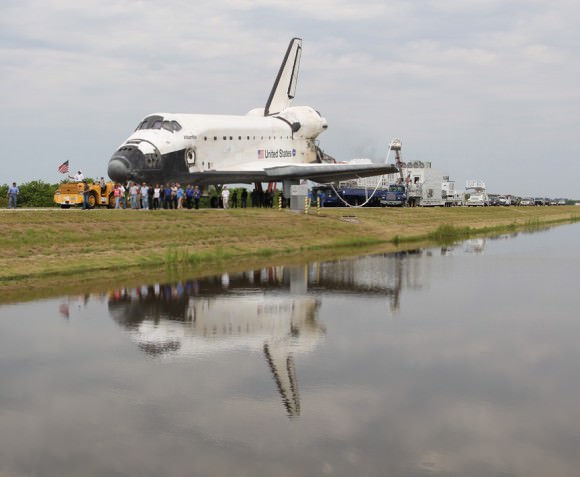

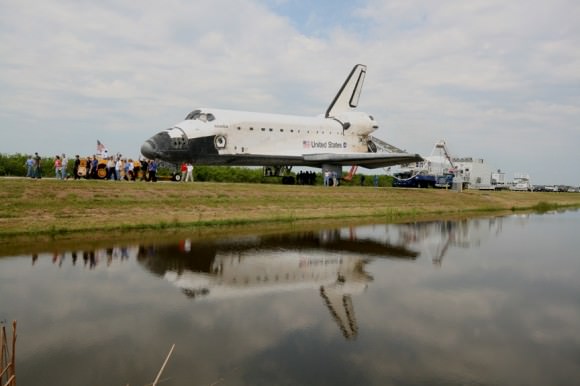
Credit: Ken Kremer
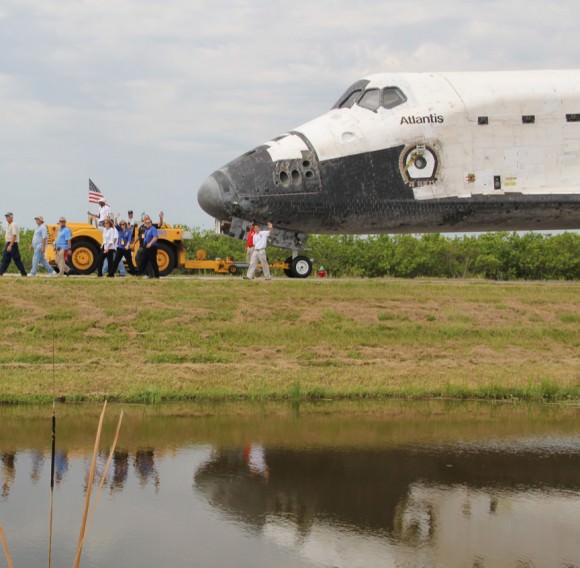
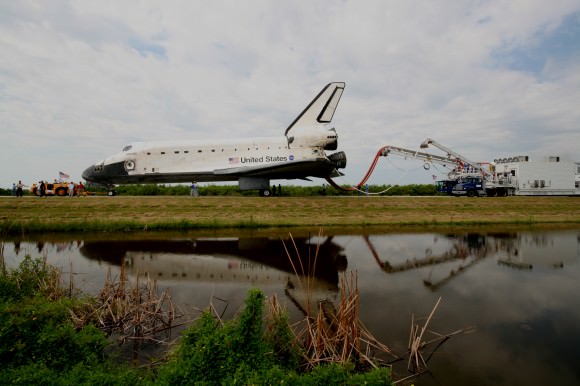
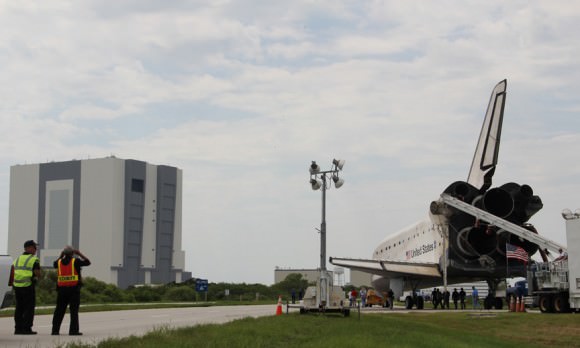
Credit: Ken Kremer
Read my features about the Final Shuttle mission, STS-135:
Wheels Stop ! With Awesome Atlantis on the Shuttle Runway – Photo Gallery Part 1
Ghostly Landing of Atlantis Closes America’s Space Shuttle Era Forever
Love of Science Drives Last Shuttle Commander – Chris Ferguson Brings Science Museum to Orbit
Revolutionary Robotic Refueling Experiment Opens New Research Avenues at Space Station
Water Cannon Salute trumpets recovery of Last Shuttle Solid Rocket Boosters – Photo Album
Shuttle Atlantis Soars to Space One Last time: Photo Album
Atlantis Unveiled for Historic Final Flight amidst Stormy Weather
Counting down to the Last Shuttle; Stormy weather projected
Atlantis Crew Jets to Florida on Independence Day for Final Shuttle Blastoff
NASA Sets July 8 for Mandatory Space Shuttle Grand Finale
Final Shuttle Voyagers Conduct Countdown Practice at Florida Launch Pad
Final Payload for Final Shuttle Flight Delivered to the Launch Pad
Last Ever Shuttle Journeys out to the Launch Pad; Photo Gallery
Atlantis Goes Vertical for the Last Time
Atlantis Rolls to Vehicle Assembly Building with Final Space Shuttle Crew for July 8 Blastoff
One On One With Space Shuttle Program’s First Pilot, Robert Crippen

[/caption]
CAPE CANAVERAL Fla. – The shuttle program has drawn to a close. Present at the final flight was one of the two men who rode fire on the very first shuttle mission – Robert Crippen. He sat down and shared his thoughts and perspectives with Universe Today regarding this turning point in aerospace history.
Crippen’s space flight career began alongside moonwalker John Young, who served as commander of STS-1. The orbiter for that flight was Columbia and the mission lasted about two days. Despite the mission’s brief time on-orbit it has come to be known as one of the most audacious test flights in aviation history.
Crippen would go on to fly three more missions on board the shuttle on missions STS-7, STS-41C and STS-41G. He would eventually become the Kennedy Space Center Director from 1992 until 1995 before working in the private sector.
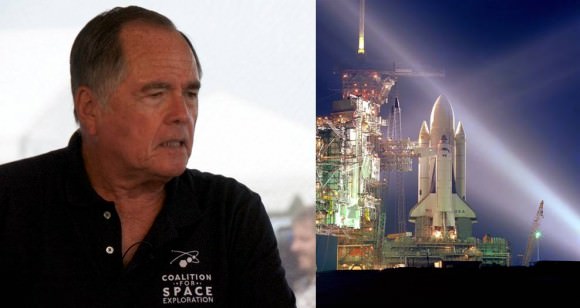
Universe Today: Thanks for talking with us today.
Crippen: Thanks for having me.
Universe Today: How do you think people will view the legacy of the shuttle program?
Crippen: “You never really know what history is going to say, but when I look back I’m really proud of the shuttle, its done revolutionary things, not just satellites, and the Hubble Space Telescope, but also the International Space Station, just accomplishment after accomplishment – but we had our share of tragedies as well. When I think of what people will think I always go back to a ‘Brooks and Dunn’ song – ‘You’re going to miss me when I am gone.”
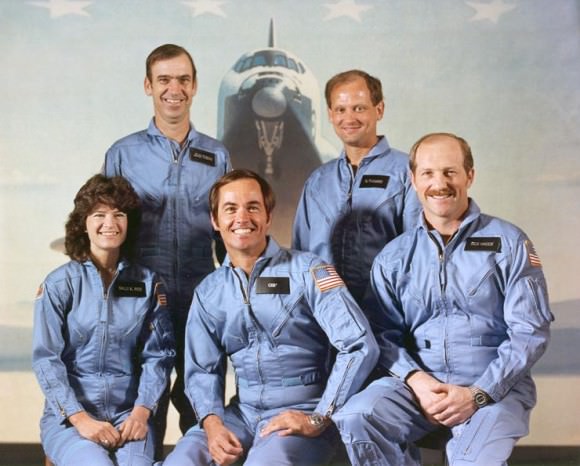
Universe Today: The shuttle that is launching today, is it all that different from what you flew on STS-1?
Crippen: “Airline pilots used to come up and tell us that their planes were better than the shuttle,” Crippen said. “You have to understand why they were saying that, when the shuttle first flew the gauges had little metal arms in them and the shuttle was still using cathode ray tubes – so yes, it is very different from I first flew on in 1981.”
Universe Today: What was it like on that first mission? Did you think with all the new technology and this completely new way of launching to orbit that you were going to go when you did?
Crippen: “I honestly didn’t think we were even going to launch when we did. But when those solids lit I had no doubt in my mind that we were going someplace! The best part was that John’s blood pressure stayed really low, like at around 90 and mine was really high, it was up around 130. All John had to say was that he was too old and his blood pressure wouldn’t go any faster.”
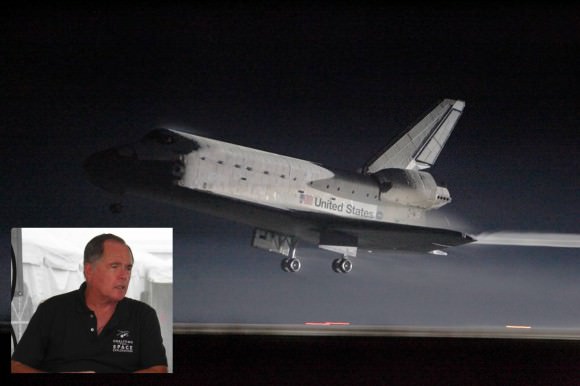
Universe Today: Bob you work with the Coalition for Space Exploration (CSE) this organization has put out a couple of well-produced Public Service Announcements lately, what are they about and why are they being released now?
Crippen: “Well, these PSAs try to focus on what I call the ‘spin-offs’ of the space shuttle program. The program has helped to produce or improve everything from heart pumps, how to rescue people out of vehicles after accidents and those types of things which, while important, one of the really important things that the space program does – is inspire.”
Universe Today: Thanks for taking the time to speak with us today, we know that you have a pretty tight schedule.
Crippen: No problem, it was my pleasure.
Crippen was kept very busy on launch day and soon he was off to another interview. As he headed out he turned and stated that he was proud that part of STS-1 (one of the Solid Rocket Booster segments) was flying on this final shuttle mission, he also made a prophetic comment concerning the weather. “You never know how the Florida weather is going to work, but I have a good feeling about today.” Less than an hour later, the final space shuttle mission thundered off of the launch pad – and into history.
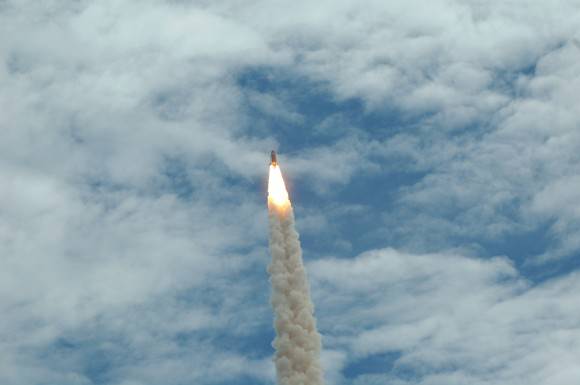
Wheels Stop ! With Awesome Atlantis on the Shuttle Runway – Photo Gallery Part 1
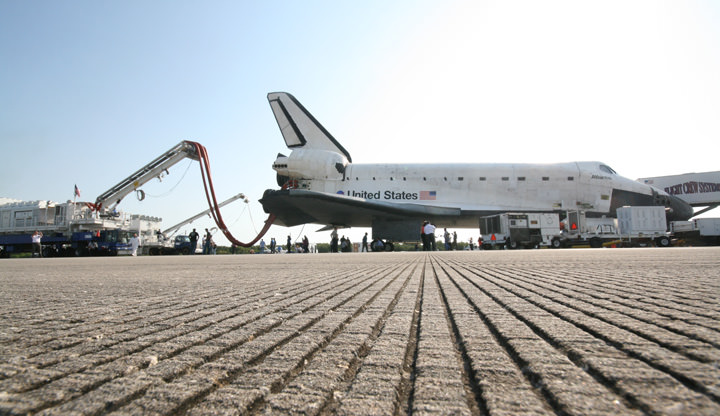
[/caption]
At Wheels Stop with Atlantis ! Here ended the Shuttle Era
A few short hours after the touchdown of Space Shuttle Atlantis closed out NASA’s Space Shuttle Era, myself and a small group of extremely lucky journalists and photographers were invited by NASA to journey to ‘Wheels Stop’ – Runway 15 at the Shuttle Landing Facility at the Kennedy Space Center for a thrilling and once in a lifetime eyewitness experience to the exact spot where Atlantis rolled to a stop.
After 30 years and 135 missions, the landing of the Final Flight of Space Shuttle Atlantis on July 21, 2011 at 5:57 a.m. concluded America’s Space Shuttle Program. The Grand Finale was commemorated with banners, quilts and celebrations at Runway 15.
The STS-135 crew comprised of Shuttle Commander Chris Ferguson, Pilot Doug Hurley and Mission Specialists Sandra Magnus and Rex Walheim.
It’s truly an honor and a privilege to be granted this extremely rare and magnificent opportunity to witness history first hand by the folks at NASA and the Kennedy Space Center – and share this with the public. Thank you !
See my Atlantis ‘Wheels Stop’ photo album below and more upcoming from Universe Today colleague Alan Walters
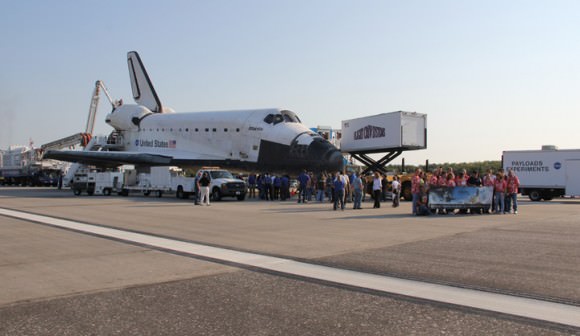
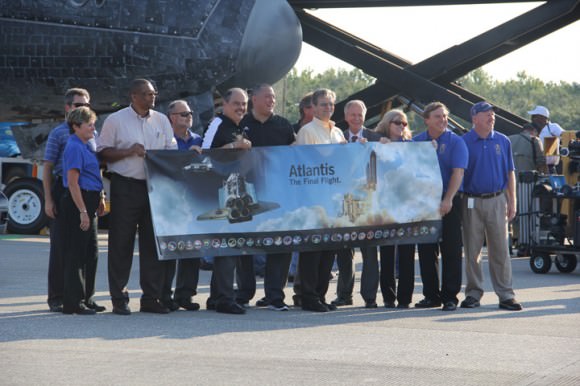
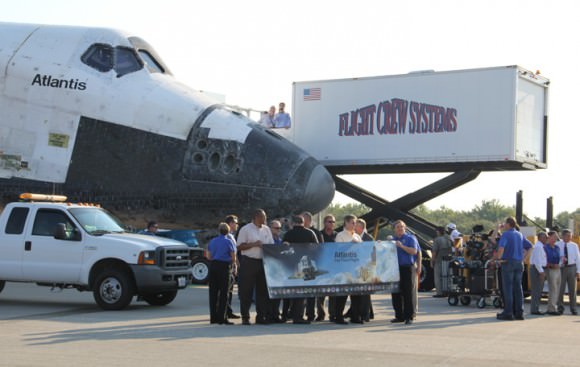
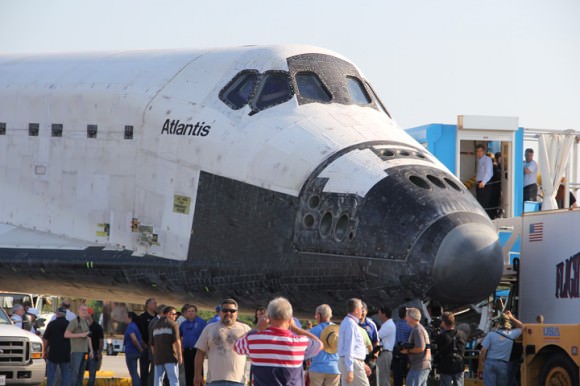
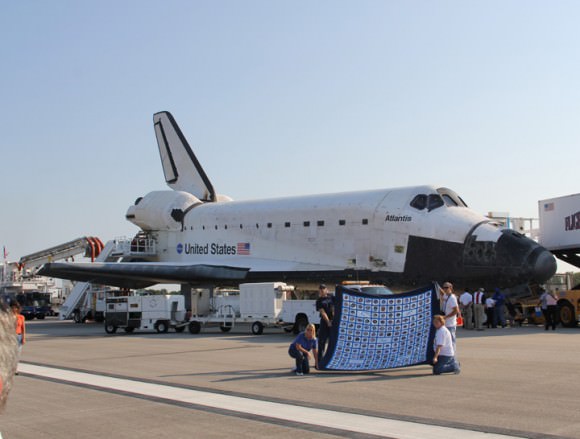
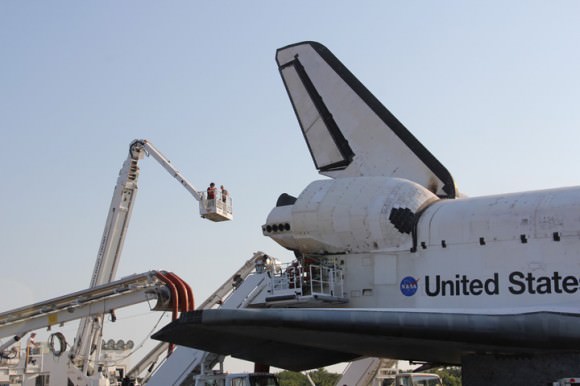
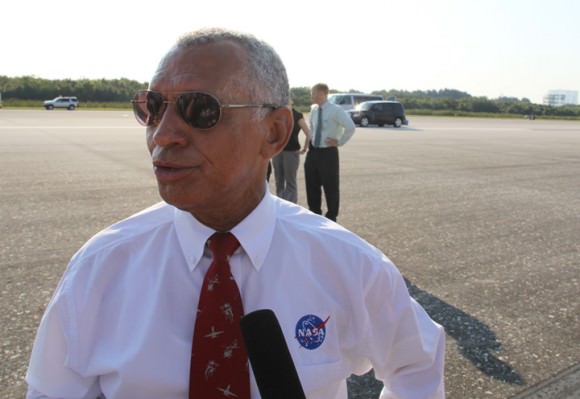
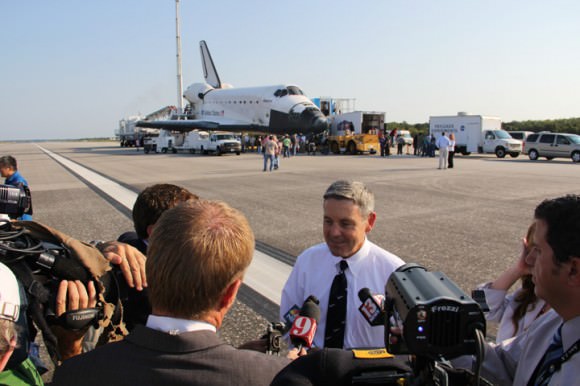
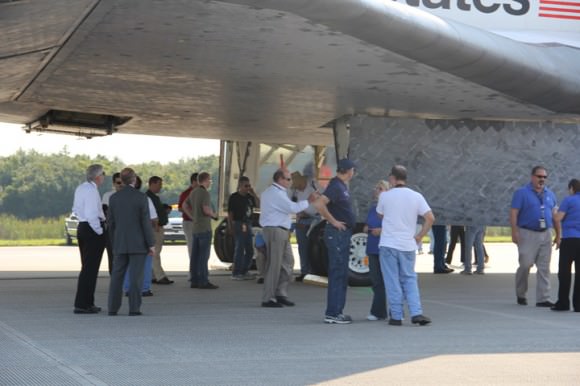
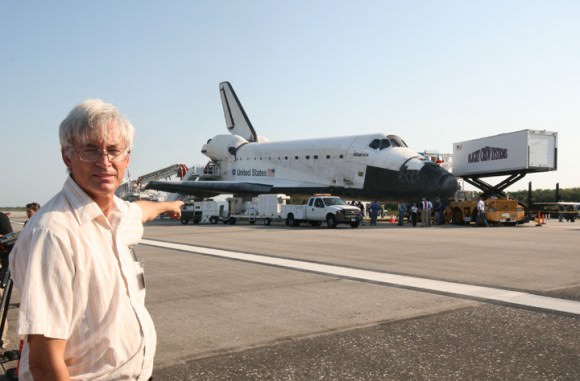
Read my features about the Final Shuttle mission, STS-135:
Ghostly Landing of Atlantis Closes America’s Space Shuttle Era Forever
Love of Science Drives Last Shuttle Commander – Chris Ferguson Brings Science Museum to Orbit
Revolutionary Robotic Refueling Experiment Opens New Research Avenues at Space Station
Water Cannon Salute trumpets recovery of Last Shuttle Solid Rocket Boosters – Photo Album
Shuttle Atlantis Soars to Space One Last time: Photo Album
Atlantis Unveiled for Historic Final Flight amidst Stormy Weather
Counting down to the Last Shuttle; Stormy weather projected
Atlantis Crew Jets to Florida on Independence Day for Final Shuttle Blastoff
NASA Sets July 8 for Mandatory Space Shuttle Grand Finale
Final Shuttle Voyagers Conduct Countdown Practice at Florida Launch Pad
Final Payload for Final Shuttle Flight Delivered to the Launch Pad
Last Ever Shuttle Journeys out to the Launch Pad; Photo Gallery
Atlantis Goes Vertical for the Last Time
Atlantis Rolls to Vehicle Assembly Building with Final Space Shuttle Crew for July 8 Blastoff
Ghostly Landing of Atlantis Closes America’s Space Shuttle Era Forever
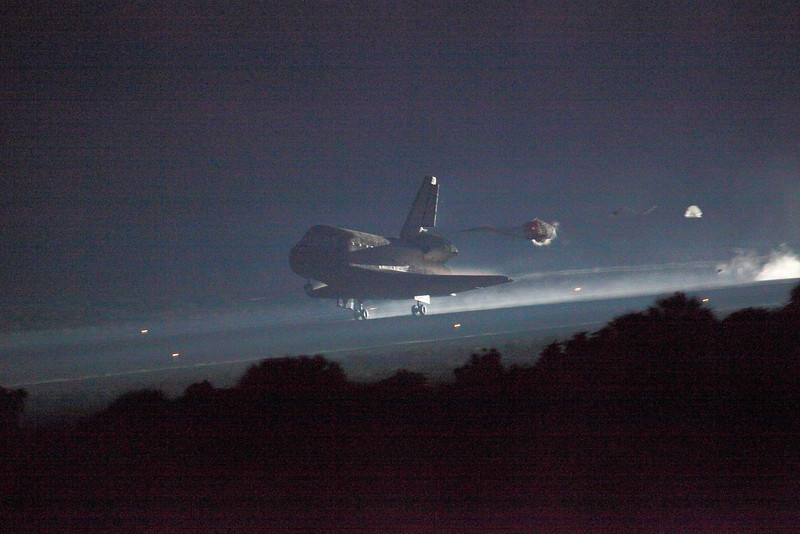
[/caption]
Barely discernable in the pre-dawn twilight and appearing as an eerie, ghost like figure, Space Shuttle Atlantis and her four person crew swiftly glided to a triumphant landing at the Kennedy Space Center that closed out NASA’s three decade long Space Shuttle Era – in the wink of an eye it was all over.
Atlantis touched down almost invisibly on Runway 15 at the Shuttle Landing Facility at 5:57 a.m. EDT and rolled to a stop moments later to conclude the history making 13 day flight to the International Space Station and back. During the STS-135 mission Atlantis orbited the Earth 200 times and journeyed 5,284,862 miles.
The all veteran crew of space flyers comprised of Shuttle Commander Chris Ferguson, Pilot Doug Hurley and Mission Specialists Sandra Magnus and Rex Walheim.
The finality of it all was at once thoroughly unbelievable that the shuttles would never fly again but utterly definitive at ‘wheel stop’ that we had witnessed the end of a historic and magnificent Era in human spaceflight.
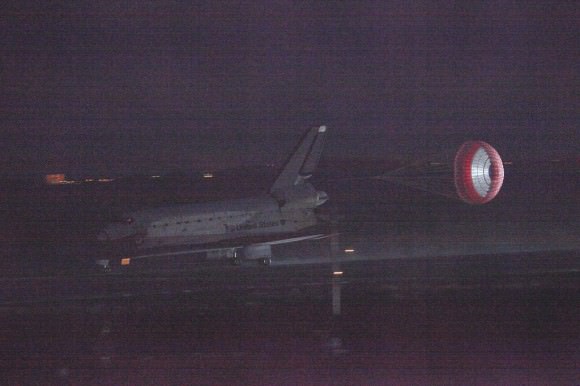
Everyone present at the shuttle landing strip let out a loud cheer and thankful applause upon the safe conclusion to the 135th and last flight of NASA’s Space Shuttle Program – since the first blastoff of Columbia on the STS-1 mission on April 12, 1981.
“Mission complete, Houston,” radioed Commander Ferguson. “After serving the world for over 30 years, the space shuttle has earned its place in history. It’s come to a final stop.”
But the sinking realization that America at that exact moment had simultaneously and voluntarily lost 100% of our indigenous national capability to send humans and cargo to the International Space Station is quite troubling to say the least.
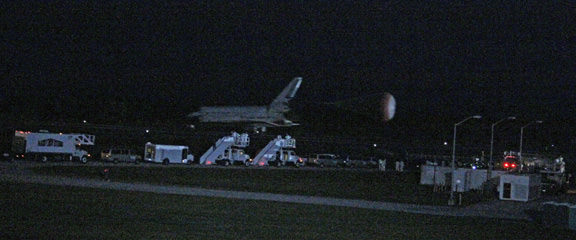
The end of the shuttle program also marked the end of employment for nearly 2000 highly talented shuttle workers in the midst of a continuing tough economic situation all across the US. And thousand more pink slips are looming.
The primary goal of the STS-135 mission was to deliver more than 9,400 pounds of spare parts, food, water, science experiments and assorted gear to the International Space Station that were loaded aboard the Raffaello multi-purpose logistics module – which functions as a ‘moving van’ in space.
All these supplies are “absolutely mandatory”, according to top NASA managers, for sustaining ISS operations for about one year into 2012. By that time NASA hopes that two US commercial space companies – SpaceX and Orbital Sciences – will have flown successful unmanned cargo flights to replace the capability completely lost with the premature retirement of NASA’s three orbiter fleet of winged Space Shuttles.
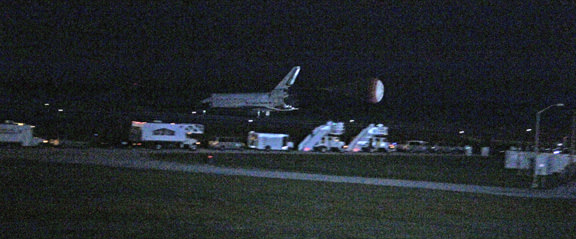
For the return trip to Earth, the 21-foot long, 15-foot diameter Raffaello brought back nearly 5,700 pounds of valuable science samples and unneeded trash to free up coveted storage space aboard the massive orbiting outpost.
“Although we got to take the ride,” said Commander Chris Ferguson on behalf of his crew,” we sure hope that everybody who has ever worked on, or touched, or looked at, or envied or admired a space shuttle was able to take just a little part of the journey with us.”
Upon departing Atlantis at the shuttle runway, Ferguson and the entire crew were welcomed back by NASA Administrator Charles Bolden and other senior officials.
“They have come to be known as the ‘final four.’ They did an absolutely incredible job,” said Bolden. “They made us very proud.”
“I really want to thank the space shuttle team and the Space Shuttle Program for just a tremendous effort today and throughout the entire history of the program. We gave them a tremendous challenge to fly and execute these missions and to finish strong and I can tell you today that the team accomplished every one of those objectives,” said Associate Administrator for Space Operations Bill Gerstenmaier at a post landing briefing for reports at the Kennedy Space Center. “I’d also like to thank the nation for allowing us to have these thirty years to go use the shuttle system.”
“It is great to have Atlantis safely home after a tremendously successful mission — and home to stay,” said Bob Cabana, Kennedy Space Center director.
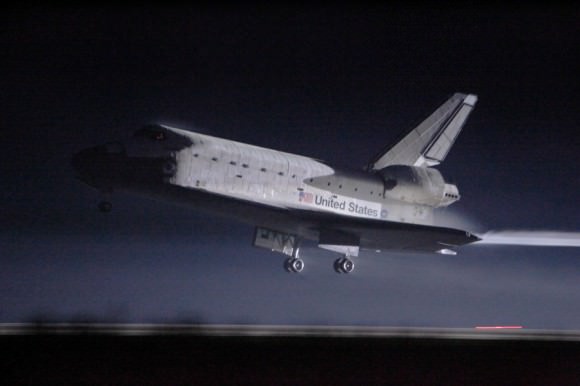
Atlantis future retirement home will be constructed just a short distance away at Kennedy Space Center Visitor Complex (KSCVC).
Visitor Complex COO Bill Moore told me that he expects Atlantis will be put on permanent public display in 2013 after completion of a new 64,000 sq. ft exhibition building to house the orbiter. Atlantis will be displayed as though it were “In Flight.”
“I’m unbelievably proud to be here representing the Space Shuttle Program and the thousands of people across the country who do the work,” said Mike Moses, space shuttle launch integration manager. “Hearing the sonic booms as Atlantis came home for the last time really drove it home to me that this has been a heck of a program.”
“The workers out here and across the country in the Space Shuttle Program have dedicated their lives, their hearts and their souls to this program, and I couldn’t be more proud of them,” said Mike Leinbach, the space shuttle launch director at KSC.
Altogether Atlantis flew 33 missions, spent 307 days in space, orbited Earth 4,848 times and traveled 125,935,769 miles. Atlantis was the last of NASA three orbiters to be retired and closed out the Space Shuttle Era.
Wheels stop marked the dreaded end of American manned spaceflight from American soil for many years to come. No one can say with certainty how or when America will again launch humans to space.
From one moment to the next America’s leadership in space position has evaporated – with the utilization of the most capable spaceship ever built and now operating at the peak of its performance yielding instead to reigning uncertainly as to what comes next given the dire outlook for the NASA budget in the foreseeable future.
A new US manned launch system – most likely in the form of a commercial “space taxi” – could perhaps lift off by mid-decade, but the task is formidable and the funding obstacles are sky high.
In the meantime, America is fully dependent on the Russians to loft Americans to space. All US astronauts headed to the ISS for the next three to five years at a minimum will be forced to hitch a ride aboard a Russian Soyuz capsule.
Atlantis Final Landing Photos contributed by Alan Walters, Ken Kremer, Mike Deep, David Gonzales, John L. Salsbury and Chase Clark
Up next: Wheels Stop with Atlantis on the Shuttle Landing Strip and Towback to the Orbiter Processing Facility
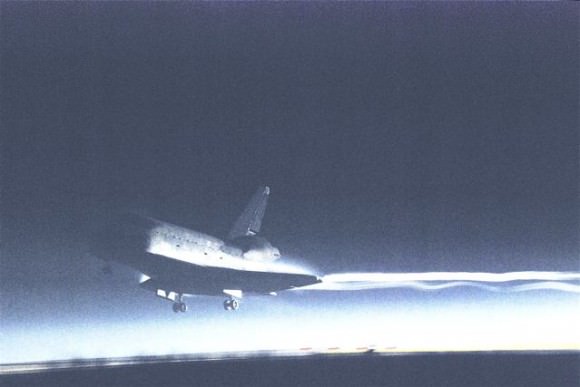
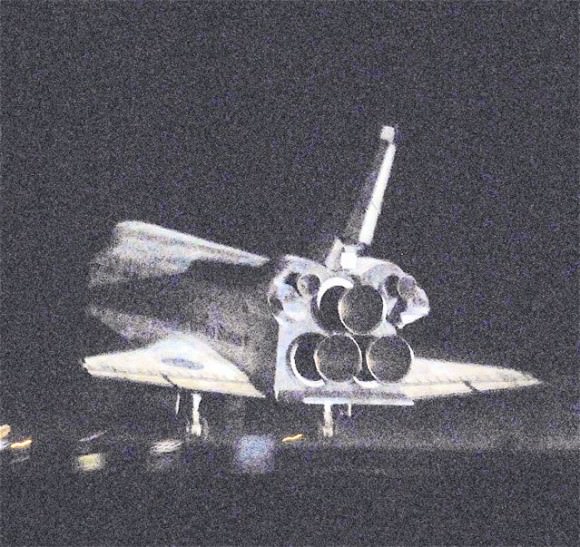
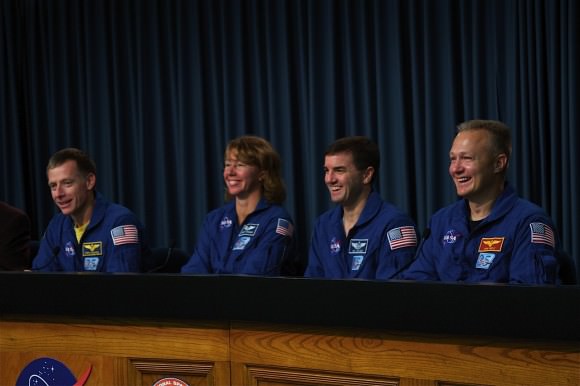
Read my features about the Final Shuttle mission, STS-135:
Love of Science Drives Last Shuttle Commander – Chris Ferguson Brings Science Museum to Orbit
Revolutionary Robotic Refueling Experiment Opens New Research Avenues at Space Station
Water Cannon Salute trumpets recovery of Last Shuttle Solid Rocket Boosters – Photo Album
Shuttle Atlantis Soars to Space One Last time: Photo Album
Atlantis Unveiled for Historic Final Flight amidst Stormy Weather
Counting down to the Last Shuttle; Stormy weather projected
Atlantis Crew Jets to Florida on Independence Day for Final Shuttle Blastoff
NASA Sets July 8 for Mandatory Space Shuttle Grand Finale
Final Shuttle Voyagers Conduct Countdown Practice at Florida Launch Pad
Final Payload for Final Shuttle Flight Delivered to the Launch Pad
Last Ever Shuttle Journeys out to the Launch Pad; Photo Gallery
Atlantis Goes Vertical for the Last Time
Atlantis Rolls to Vehicle Assembly Building with Final Space Shuttle Crew for July 8 Blastoff
The Last Space Shuttle’s Return in 3-D
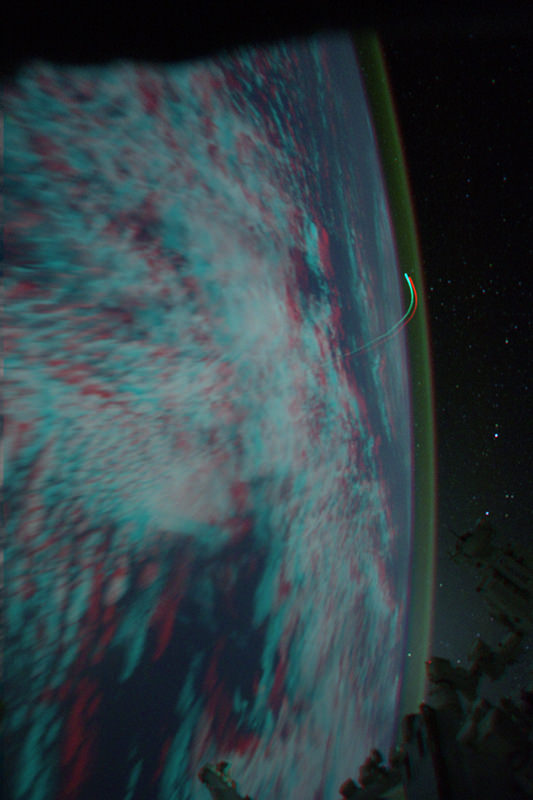
[/caption]
We shared an image yesterday of an amazing view of Atlantis on its way home taken by the Expedition 28 crew of the space station. 3-D-ifier Nathanial Burton Bradford has now given a new perspective to this image, making a 3-D image, best seen with red/cyan glasses. Amazingly, in this view the contrail left by the shuttle as is travels through Earth’s atmosphere even *looks* far away, how it must have looked to the ISS crew.
Also, Nathanial created a 3-D version of Atlantis’ final launch, below:
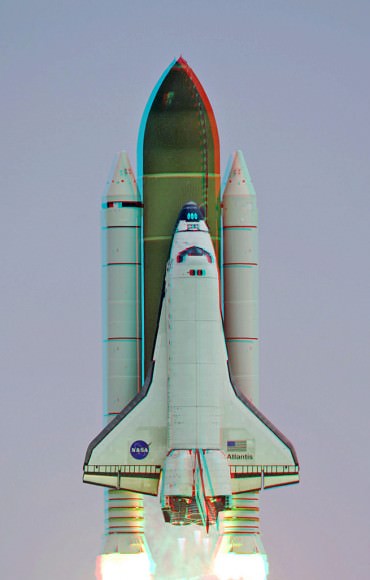
Thanks to Nathanial Burton-Bradford for sharing his images. See more on his Flickr page, including Atlantis in orbit and a view from the space station.
A Moving Tribute to Every Single Space Shuttle Mission
The space shuttle program has now come to an end and most of us are feeling a bit nostalgic. Want to look back over the past 30 years? This video does just that, showing all the shuttle missions in chronological order in just over 8 minutes. It’s a moving look at the missions, the people, and the shuttles themselves.
